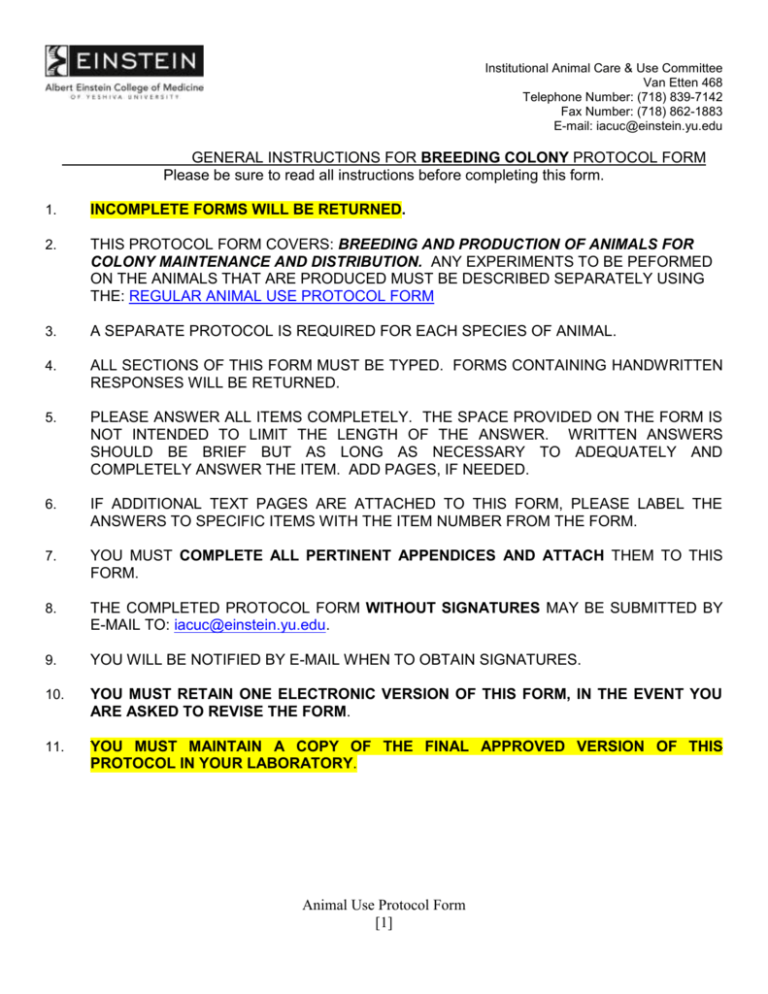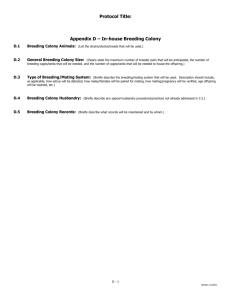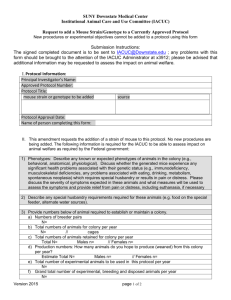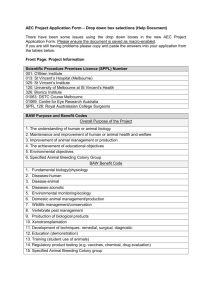Breeding Animal Use Protocol
advertisement

Institutional Animal Care & Use Committee Van Etten 468 Telephone Number: (718) 839-7142 Fax Number: (718) 862-1883 E-mail: iacuc@einstein.yu.edu GENERAL INSTRUCTIONS FOR BREEDING COLONY PROTOCOL FORM Please be sure to read all instructions before completing this form. 1. INCOMPLETE FORMS WILL BE RETURNED. 2. THIS PROTOCOL FORM COVERS: BREEDING AND PRODUCTION OF ANIMALS FOR COLONY MAINTENANCE AND DISTRIBUTION. ANY EXPERIMENTS TO BE PEFORMED ON THE ANIMALS THAT ARE PRODUCED MUST BE DESCRIBED SEPARATELY USING THE: REGULAR ANIMAL USE PROTOCOL FORM 3. A SEPARATE PROTOCOL IS REQUIRED FOR EACH SPECIES OF ANIMAL. 4. ALL SECTIONS OF THIS FORM MUST BE TYPED. FORMS CONTAINING HANDWRITTEN RESPONSES WILL BE RETURNED. 5. PLEASE ANSWER ALL ITEMS COMPLETELY. THE SPACE PROVIDED ON THE FORM IS NOT INTENDED TO LIMIT THE LENGTH OF THE ANSWER. WRITTEN ANSWERS SHOULD BE BRIEF BUT AS LONG AS NECESSARY TO ADEQUATELY AND COMPLETELY ANSWER THE ITEM. ADD PAGES, IF NEEDED. 6. IF ADDITIONAL TEXT PAGES ARE ATTACHED TO THIS FORM, PLEASE LABEL THE ANSWERS TO SPECIFIC ITEMS WITH THE ITEM NUMBER FROM THE FORM. 7. YOU MUST COMPLETE ALL PERTINENT APPENDICES AND ATTACH THEM TO THIS FORM. 8. THE COMPLETED PROTOCOL FORM WITHOUT SIGNATURES MAY BE SUBMITTED BY E-MAIL TO: iacuc@einstein.yu.edu. 9. YOU WILL BE NOTIFIED BY E-MAIL WHEN TO OBTAIN SIGNATURES. 10. YOU MUST RETAIN ONE ELECTRONIC VERSION OF THIS FORM, IN THE EVENT YOU ARE ASKED TO REVISE THE FORM. 11. YOU MUST MAINTAIN A COPY OF THE FINAL APPROVED VERSION OF THIS PROTOCOL IN YOUR LABORATORY. Animal Use Protocol Form [1] THIS PROTOCOL IS ONLY FOR BREEDING AND PRODUCTION OF ANIMALS FOR COLONY MAINTENANCE AND/OR DISTRIBUTION You may only use this form to describe: Breeding and production of animals for colony maintenance and/or distribution. Specific procedures needed to identify and select genotypes to facilitate line maintenance may be included. Any experiments to be performed on these animals must be described separately under: Regular Animal Use Protocol Form NO EXPERIMENTAL PROCEDURES MAY BE PERFORMED ON THE ANIMALS This box is for IACUC Office Use Only. Please do not enter any information in this box. Received: Protocol Number: Delegated Review List: Assignment: Full Review RSC Meeting IACUC Meeting Review Letter(s): Revision(s) Date Tabled: Delegated Review Date of Assigned to Delegated Reviewer(s): Reviewer(s): Approved: GENERAL PROTOCOL / CONTACT INFORMATION A. Principal Investigator Information: Name: Academic Title: Department: Mailing Address: Office Location: Laboratory Location: e-mail: Office phone: Laboratory phone: [2] B. Protocol Information: Protocol Title: Species: Is this project ongoing? Only one species may be listed. Yes. Provide Protocol number: . No. Provide anticipated start date: Campus where colony will be maintained: Einstein MMC . YU C. Funding Information: Is this breeding / animal production program funded by a granting agency? Check Yes OR No below and provide appropriate information. No. Provide information below: How will program be funded?: Yes. Provide information below: Name of Agencies: D. Departmental/Laboratory Information: D1. Department Administrator Name: Mailing Address: Telephone Number: e-mail: Fax: E. Personnel and Qualifications. In the table provided on the next page, provide name(s) of all individual(s) who will work in this animal breeding program. THE TABLE MUST INCLUDE THE PRINCIPAL INVESTIGATOR, EVEN IF HE/SHE WILL NOT BE HANDLING THE ANIMALS. For all personnel listed, describe their education and relevant experience with breeding colony maintenance, animal production, and the procedures described. Please note that in order to for this protocol to be approved, the personnel listed must have completed all mandatory training pertinent to this animal use protocol. List of IACUC Training Sessions (CONSISTS OF TWO PARTS): CITI Training Modules. Face to Face Training Sessions. Below is a list of the face to face training sessions. Training Session # Training Session Title 1 New User’s Orientation to Research Animal Use at EINSTEIN Mandatory for all. 4 Safe and Humane Rodent Handling, Anesthesia, Analgesia and Euthanasia Mandatory if this is the first time you will be handling rodents at Einstein. [3] YOU MUST FILL IN ALL INFORMATION. 1. Principal Investigator Name: Degrees: E-mail Address: Years of Experience: Does this person have experience relevant to handling and experimental Yes manipulation of animal species as described in this protocol? Will this person handle live animals under this protocol? Yes Will this person euthanize animals under this protocol? Yes 2. Lab Manager/Person to Contact if PI is not Available Name: Degrees: Role in Study: E-mail Address: Years of Experience: Does this person have experience relevant to handling and experimental Yes manipulation of animal species as described in this protocol? Will this person handle live animals under this protocol? Yes Will this person euthanize animals under this protocol? Yes 3. Laboratory Personnel Name: Role in Study: E-mail Address: Does this person have experience relevant to handling and experimental manipulation of animal species as described in this protocol? Will this person handle live animals under this protocol? Will this person euthanize animals under this protocol? 4. Laboratory Personnel Name: Role in Study: E-mail Address: Does this person have experience relevant to handling and experimental manipulation of animal species as described in this protocol? Will this person handle live animals under this protocol? Will this person euthanize animals under this protocol? No No No No No Degrees: Years of Experience: Yes No Yes Yes No No Degrees: Years of Experience: Yes No Yes Yes FOR ADDITIONAL PERSONNEL DOWNLOAD ADDITIONAL PERSONNEL SHEET FROM IACUC WEBSITE. [4] No No No 1. Purpose (Narrative). Briefly describe the breeding colonies included in this protocol. You should identify and list all the strains and specific genotypes (including transgenes or genome modifications) in the table (item 2 below) and explain the purpose of each (why they are being produced) below. Your response you should explain the following: The characteristics of each animal strain/ genotype being produced (known or expected phenotypes) Why these characteristics are important – explaining why these animals are being generated. What scientific studies these animals would be used to support at EINSTEIN Any phenotype with clinical signs or possible illness. PLEASE keep this clear and concise, as if you are attempting to provide an encapsulated description to a group of basic science students. Limit this description to 1-2 simple paragraphs. Response: ANIMAL SUBJECT DESCRIPTION 2. Strains and Genotypes . List the specifc strain(s) and genotypes being maintained. Strain and genotypes(s) Expected Abnormal Phenotype (if any) Strain 1: Strain 2: Strain 3: Provide total number of animals being bred / produced: The total above should match number explained below. 3. Explanation of Animal Numbers. You must estimate the total number of animals that could be produced on this breeding protocol for each strain / line being maintained. A clear explanation of how that estimate was calculated MUST be provided so that reviewers can understand how the breeding program is setup and production estimates were derived. You must account for the number of breeders and the total production of each of the lines listed above, including any animals discarded because of unwanted genotype and any other surplus. If replacement breeding animals are periodically obtained / purchased from outside sources collaborators or commercial vendors -, please specifically state how many will be obtained. The description should include the breeding unit format (breeder pair, harem (trio), etc) expected litter size, and expected number of litters per year from each breeding unit. A general statement about the number of offspring targeted for production should be given. When describing lines that do not breed true (heterozygous matings, cross-breedings, etc), a useful way to start is to estimate the desired (targeted) number of rarest genotype produced and back calculate based on fecundity, number of litters per year, genetic probability, etc. Please see examples of how to calculate animal numbers on IACUC website under Examples of Tables. [5] Explanation: ANIMAL HUSBANDRY AND CARE 4. Animal Housing Location Requested. (Check all that apply) Einstein (complete ALL information below): Where in IAS would you like to house animals? (check all that apply) Chanin Kennedy Center Ullmann Building Price Center What type of housing are you requesting? (check all that apply) Barrier Conventional Isolator (“Bubble) Off site (Describe location): 5. Special Husbandry, Handling, Treatments, Hazards, Etc. All husbandry and care practices must meet standards described in the Animal Welfare Regulations and the Guide for the Care and Use of Laboratory Animals. Specific exceptions are granted only when specific scientific justifications are provided or mandated by the veterinarian for medical reasons. 5A. Special husbandry needs. Will any of the animals in this breeding colony require special husbandry or handling practices and procedures? (CHECK ONE) No. Proceed to 5B. Yes. Complete Appendix 1 then proceed to 5B. 5B. Treatments. Will substances (treated water, treated feed, injections) need to be administered to animals (for example, to either maintain induction or suppression of gene expression) as part of routine colony maintenance production? No. Proceed to 5C. Yes. Complete Appendix 1 then proceed to 5C. 5C. Biohazards. Have any of the animals been developed to genetically express any agents, such as toxins, prion protein, viruses, that may be hazardous to humans or animals if they are exposed to tissues, secretions, or excretions from these animals? No. Proceed to 6. Yes. Complete Appendix 1 then proceed to 6. ANIMAL PROCEDURES 6. Collection of tissue for genotyping, identification procedures, and/or euthanasia may be performed as a routine component of breeding colony maintenance ONLY. Non-terminal procedures should be performed in the animal room. 6A. Specimen Collection. (All body fluids and tissues are considered specimens). Will animal require genotyping or other sample collection to evaluate their genotype, phenotype or part of the production colony? [6] No. Proceed to item 7. Yes. Complete Appendix 2 then proceed to 7. SPECIAL CONSIDERATIONS OF REGULATORY OR VETERINARY CONCERN 7. Clinical Illness in Animals. Will genetically induced conditions (spontaneous mutation, targeted mutation, or transgene), cause any animals to show any clinically apparent disease or phenotype (e.g. diabetes, tumors)? No. Proceed to item 8. Yes. Complete Appendix 3 see “NOTE” below and then proceed to 8. NOTE: Animals that have an expected abnormal phenotype should be flagged with an expected phenotype card to alert the care staff. These pink phenotype cards can be obtained from IAS in consult with veterinary staff. Please contact IAS at 718.839.7100. Since this protocol is ONLY for breeding and production of animals for colony maintenance and distribution, it is expected and assumed that any animals that interfere with their use for future breeding will be either euthanized immediately or transferred to an approved animal study (protocol) that fully describes the scientific goals and purpose for keeping that animal alive. If you must maintain clinically abnormal animals on this protocol for breeding, you must complete APPENDIX 3. 8. Will any animals be moved on to another study? No. Proceed to item 9. Yes. Complete 8A then proceed to 9. 8A. For animals that will be moved onto other studies, please identify (cross reference) the approved Animal Use Protocol(s) to which animals exhibiting clinical abnormalities will be transferred routinely. Protocol No: When this was approved by IACUC: PI: EUTHANASIA OR OTHER DISPOSITION OF ANIMALS 9. Euthanasia. How will surplus or unwanted animals be euthanized? 9A. Describe method of euthanasia below then proceed to 9B. Check all that apply Isoflurane Overdose1 Ketamine/Xylazine Overdose Dose (check species) Rat – 100/20 mg/kg Carbon Dioxide (Inhalation to effect)2 Other. Describe: Dose: Route: 1 Mouse – 200/20 mg/kg Isoflurane is a volatile anesthetic and must be used either in a chemical fume hood or with a carbon filter scavenging unit. [7] 2 CO2 MUST BE DELIVERED BY COMPRESSED GAS CYLINDER (INHALED ROUTE) TO EFFECT (DOSE). THIS IS THE ONLY APPROVED METHOD FOR USING CO2. NOTE: For guidance on acceptable methods of euthanasia, refer to the most current Report of the AVMA Guidelines on Euthanasia. 9B. Check below how death will be ensured then proceed to 10. Cervical Dislocation Blanching of the eye ball (pale globe, indicating no blood is flowing through the eye) Decapitation NOTE: In addition to what has been checked above, death must be ensured by confirming: Lack of Heartbeat for one minute Lack of Response to Stimulus (e.g. toe pinch) Lack of Respiration for one minute 10. Consideration of Alternatives. This is a breeding protocol, and the only procedures that may be used are those to identify, genotype, or phenotype animals in order to select offspring for distribution or future breeding. Nevertheless, you are required by federal law and EINSTEIN policy to declare if any procedure to be employed has the potential to cause more than momentary or slight pain or distress and document that a good faith effort to consider alternatives less painful or distressful procedures. Please provide a narrative description (below) of the methods and sources used to determine that suitable alternatives (to each potential painful procedure, e.g. a different procedure, or method) were not available or applicable to this study. The following information must be included. 10A. Databases and Resources used (check any that were used below): AGRICOLA database AWIX TOXLINE database Scientific Journals Altweb MEDLINE database BIOSIS database Scientific Meetings AWIC CAB Abstracts database Other Database: Scientific Discussions NORINA When using databases, identify the search terms, years covered, and date of the search below. Date that literature search was performed: Objective of search: Years covered by the search: Search terms (keywords). If surgery, such as toe amputation (i.e. toe clipping), is being performed, include any alternative or less invasive procedures in Search terms (keywords): You must include the key words “alternative, and the painful/distressful procedure you are performing. Narrative (must address each [8] procedure explicitly): MANDATORY CONSIDERATIONS 11. The following are mandatory considerations when breeding and producing animals for colony maintenance and/or distribution: EINSTEIN POLICIES (Go to IACUC website) FEDERAL REQUIREMENTS 12. REMINDER: ANIMALS CARRYING HUMAN STEM CELLS MAY NOT BE BRED. 13. APPENDICES CHECKLIST ATTACHED (please check appropriate boxes, then see item 14) Appendix 1 – SPECIAL HUSBANDRY PRACTICES Appendix 2 – SPECIMEN COLLECTION Appendix 3 – CLINICAL ILLNESS, ABNORMAL PHENOTYPES 14. SIGNATURES: You will be sent a signature sheet and be notified when to obtain signatures by the IACUC office. [9] BREEDING COLONY MAINTENANCE PROTOCOL APPENDIX 1 SPECIAL HUSBANDRY PRACTICES FOR BREEDING COLONIES 1. Special Husbandry: Separately for each specific breeding strain / line, check and completely describe any and all nonstandard practices or procedures required (examples listed below). Multiple strains may be listed if they receive identical treatment. Then go to 2. Strain/ genotype 1 Check Procedure Description Justification / Rationale Nonstandard caging Special Feed (indicate below): special formula powdered food medicated feed Medicated Water/Special treated Other Specific Treatments Exemptions from standard cage maintenance Non-standard temperatures Non-standard light cycle Restricted environmental enrichment Restricted observation Special monitoring or nursing care Weaning rodents beyond 21 days of age Biohazardous agent For additional Appendix 1 for the Breeding Protocol (for other Strains, please visit IACUC website) 2. Personnel responsible for performing special husbandry: Specific arrangements and standard operating procedures (SOPs) must be in place for carrying out special husbandry above. The section below must describe these procedures to be followed, and must delineate specific staff responsibilities. Written description of SOPs and delineation of responsibilities for special husbandry described above: Response: [10] NOTE: Special Husbandry Cards: You are required to affix the appropriate “Special Husbandry Card” to all cages. These cards are custom designed. Please consult with veterinary staff of the Institute for Animal Studies (IAS) to make arrangements in advance of beginning a study that requires special husbandry to prepare the “Special Husbandry Card” (718.839.7100). By completing this appendix, you acknowledge that you have read this statement and that you will contact the veterinary staff in order to obtain the appropriate “Special Husbandry Card”. 3. Specific research personnel who will be responsible for ensuring proper husbandry and who may be contacted by the IAS in emergencies or if there are questions or concerns, must be identified below: Name of Individual(s) Responsible for Special Husbandry Work Telephone Number [11] After Hours Telephone BREEDING COLONY MAINTENANCE PROTOCOL APPENDIX 2 SPECIMEN COLLECTION 1. Using the table below, please describe the specimen collection procedure that will be employed to genotype/phenotype animals as part of the colony maintenance, breeding selection process. Tissue / fluid collected Method of Collection Tissue For Genotyping* Ear Punch (preferred) Tail Biopsy (may require anesthesia Toe Clipping Amount or volume collected per sample Age and Frequency of sampling Maximum number of samples that will be collected Blood Collection Urine Feces Other. Describe below. Fill in each column. If performing blood collection, bleeding of the animal must be controlled by using pressure. Also, silver nitrate is available through the Institute for Animal Studies (718-430-8749). 2. Have you indicated that tissue for genotyping will be collected above? No. Proceed to 3. Yes. Read information below, then to go 2A. NOTE: Please see Policy on Tail Clipping Mice and for Genotyping For tail biopsy, samples should be collected only once. For routine tissue genotyping, an ear punch biopsy is preferred. However, either tail biopsy or toe clipping are allowed methods under strict conditions (published under IACUC Policy 2011-2 and 2012 respectively). Specifically: a. Anesthesia is not required for toe clipping performed on neonates < 10 days old. b. Anesthesia is not required for tail tip biopsy (2-5 mm) perfomed on pups < 21 days old. c. Local anesthesia is required for either toe clipping or tail biopsy performed on pups 10 – 21 days old. d. General anesthesia is required for tail biopsy or toe clipping in rodents > 21 days old. 2A. Will all the policy conditions noted above be met? No. Complete 2B then proceed to 3. Yes. Proceed to 3. 2B. Provide a scientific justification (with references) provided below and the search for alternatives section must be completed. [12] Rationale: 3. Will samples for Genotyping be collected by more than one method? No. Yes. Provide rationale below. Rationale: 4. Will any of these procedures be performed under anesthesia according to the published policy? No. Provide rationale in 2B (above). Check appropriate box Yes. Complete table below. Anesthetic Drug Dose Route of Administration Tissue for Genotyping Blood Collection Other 3. Restraint: Describe all methods of restraint used to carry out those specimen collection procedures general anesthesia is not induced. Method of Restraint: [13] BREEDING COLONY MAINTENANCE PROTOCOL APPENDIX 3 CLINICAL ILLNESS, ABNORMAL PHENOTYPES If you must maintain clinically abnormal animals on this protocol for breeding, you must complete the following FOR EACH AFFECTED STRAIN OR BREEDING LINE. 1. For each breeding line / genotype listed (in Table 2 of main Protocol form) that may exhibit clinical illness or abnormal phenotype please describe what signs may be seen (this can be based on published or known phenotypes, or what MAY BE ANTICIPATED based on the human condition being modeled). Strain / genotype 1: Potential for malformations/developmental anomalies. Potential for early post-natal death Other (Identify) (Describe abnormal phenotype): Potential for development of delayed development /slow post-natal growth Potential for abnormal behavior affecting survival Describe how frequently animals will be checked/monitored and specifically state monitoring procedures Criteria for euthanasia (humane endpoint) Strain / genotype 2: Potential for malformations/developmental anomalies. Potential for early post-natal death Other (Identify) (Describe abnormal phenotype): Potential for development of delayed development /slow post-natal growth Potential for abnormal behavior affecting survival Describe how frequently animals will be checked/monitored and specifically state all monitoring procedures: Criteria for euthanasia (humane endpoint): NOTE: Animals that have an expected abnormal phenotype should be flagged with an expected phenotype card to alert the care staff. These pink phenotype cards can be obtained from IAS in consult with veterinary staff. Please contact IAS at 718.839.7100. The IAS veterinary staff must be consulted for assistance with implementation of monitoring documentation (Pink monitoring documentation cards to be affixed to each cage). Please contact IAS at 718.839.7100. IF there is a plan for treating breeding animals with abnormal phenotypes, this must ALSO be described under Special Husbandry (above). [14]






